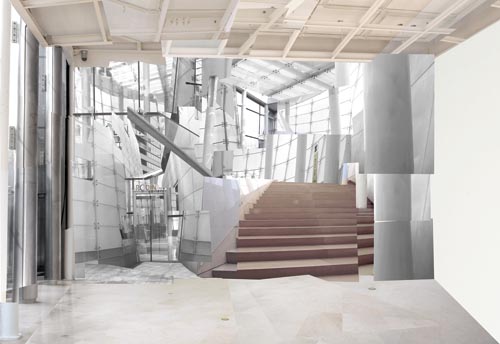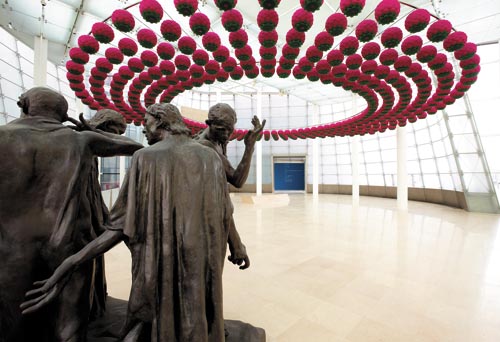Rodin Gallery reopens on a new Plateau

“Metamorphosis” (2011) by Jung Jae-ho
The area around City Hall Station in central Seoul is known more as a business district than an art zone. Still, it has a few important museums including the Seoul Museum of Art and the Deoksu Palace Museum.
Another gallery can be added to the list today, when the Rodin Gallery, operated by Leeum, Samsung Museum of Art, reopens under the new name Plateau after being closed for the past three years.
“The name Plateau comes from the geological term for a high plain or sedimentary layer,” explained Hong Ra-young, Leeum’s deputy director. “Plateau will be a space where experimental works are layered on top of what we know about historical artworks and both are reinterpreted together.”
The gallery still has its collection of works by the famous French sculptor Auguste Rodin (1840-1917), which gave the gallery its name when it was inaugurated in 1999.
But since its founding, the galley has been and will continue to be focused on contemporary art, so the name has been changed to avoid confusion, gallery officials explained.
Those who visit the gallery in the coming months will see hot pink lotus lanterns hanging from a circular frame installed in the ceiling of the Glass Pavilion while Gregorian, Tibetan and Islamic chants echo in odd harmony around them.

“Lotus: Zone of Zero” (2011) by Kim Sooja
“Metamorphosis” (2011) and “Lotus: Zone of Zero” (2011) are part of the “Space Study” exhibit, held to celebrate the opening of Plateau (formerly the Rodin Gallery). Provided by the gallery
The installation is by the renowned local artist Kim Sooja and is part of the exhibition “Space Study,” which is being held to celebrate the gallery’s reopening and runs through July 10.
Kim’s installation stands in striking visual contrast to two famous black bronze works by Rodin - “The Gates of Hell” and “The Burghers of Calais.”
“Space Study” includes the participation of 14 artists including Kim, who have made site-specific installations, photographs and video art that carry their interpretations of the old Rodin Gallery and the new Plateau.
The works by Kim Do-kyun, which at first glance look like abstract paintings, are actually photos of corners and baseboards, the spaces in Plateau where planes and lines meet.
“The space captured in his frame is no longer something that was three-dimensional. It is a vertically and horizontally refined plane that becomes an object of contemplation,” said Ahn So-yeon, chief curator of Plateau.
Similarly, Kim Kin-ae’s works also reflect her observations of the gallery space. She invites viewers to focus on the narrow unused outdoor space between the gallery’s Glass Pavilion and the other exhibition halls by installing hot pink borders there, raising questions about why the space exists. In another exhibition hall, she installed observatories with wheels, causing the irony that what looks very stable at first is not actually so.
The other participants are both emerging artists and famous names such installation artists Lee Bul and Ahn Kyu-chul.
To encourage workers from offices nearby to visit the gallery at lunchtime, the gallery hosts a quick 10-minute introduction to the exhibit at 12:40 p.m. every Wednesday.
The gallery also offers a full introduction to the show at 2 and 4 p.m. on weekdays and at 11 a.m., 2 p.m. and 4 p.m. on weekends.
*The exhibition runs through July 10. Admission is 3,000 won ($2.79) for adults. The gallery is open from 10 a.m. to 6 p.m and is closed on Mondays. Go to City Hall Station, line No. 1 or 2, exit 8, and walk for 5 minutes. For details, visit www.plateau.or.kr or call 1577-7595.
By Moon So-young [symoon@joongang.co.kr]
한글 관련 기사 [중앙일보]
‘넥타이 부대’도 즐기는 현대미술의 속살
‘플라토’로 이름 바꾼 로댕갤러리
5일 3년 만에 재개관 기념전
김수자·이불·노재운·구동희
갤러리 공간 새롭게 풀어내
지난 10년간 서울 도심의 ‘문화 오아시스’ 역할을 해왔던 태평로 로댕갤러리가 ‘플라토(plateau)’라는 새 이름으로 재개관한다. 문 닫은 지 3년만이다. 퇴적층·고원이라는 뜻의 ‘플라토’는 프랑스 철학자 들뢰즈와 가타리의 『천 개의 고원』에서 따왔다. 과거 예술적 성과와 현재·미래의 실험이 만나 재해석되는 퇴적층이라는 의미다. 예술적 고지라는 뜻도 있다. 현대미술의 용광로 역할을 하겠다는 의지가 읽힌다.
5일부터 7월 10일까지 열리는 재개관 기념전은, 과거 공간의 역사성, 장소성에 대해 다양한 재해석을 시도하는 ‘스페이스 스터디(spae study)’다. 김수자·이불·안규철 등 국내 현대미술을 대표하는 간판 스타부터 Sasa[44]·노재운·구동희 등 중진과 신진 14명이 모여 익숙한 공간을 새롭게 해석했다.
로댕의 ‘지옥의 문’과 ‘깔레의 시민’이 상설 전시되는 글래스 파빌리온에는 김수자의 ‘연꽃:제로지대’가 설치됐다. 384개의 연꽃이 원을 그리며 매달렸다. ‘지옥의 문’이 인간 존재의 종말을 보여줬다면 연꽃환은 그 공간을, 시작도 끝도 없고 모든 존재를 초월한 공존과 포용의 공간으로 둔갑시킨다. 티베트 승려의 만다라(曼茶羅) 독송과 그레고리안 성가, 이슬람성가가 함께 흘러나와 신비함을 배가시킨다.
전시장 입구에 해당하는 푸른 벽에는 난수표 같은 숫자가 써있다. 철저한 자료수집가이자 자료활용가로 유명한 Sasa의 작품이다. 로댕갤러리가 문을 연 1999년 전세계에서 일어난 107개의 사건을 수치화했다. 테러·사고 등 주로 죽음에 대한 기록이다. 바탕색인 아쿠아 블루는, 작가의 애장품인 오노 요코 앨범 자켓에서 따온 것이다. 오노 요코는 로댕갤러리의 역대 전시 중 최고 관객을 동원했다. 또 그 자신이 비극적 죽음과 연루된 인물이기도 하다.
비로 옆 김도균의 사진은 미니멀 추상회화처럼 보이지만, 갤러리의 구석구석을 확대해 찍은 것이다. 의미 없는 틈새 공간을 새로운 미학적 대상으로 해석한 것이다. 정재호는 플라토의 외부 전경과 내부 이미지가 마구 충돌하고 엉킨 초대형 사진 콜라주(collage)를 내놓았다. 대상에 대한 파편화된 인식의 한계를 보여주는 듯하다.
김민애는 전시장 안에, 전시공간의 철골구조를 흉내 낸 바(bar)를 세운다. 견고해 보이고, 마땅히 견고해야 할 나무 바 아래는 이동식 바퀴가 달려있다. 킥 웃음이 나올 정도로, 미술관의 무게를 일순간에 덜어버린다. 미술관 건축물 자체에 관심 많은 김무준은 구겐하임·테이트 모던 등 세계 유명 미술관의 외관을 단순한 아이콘처럼 만든 아크릴 패널 작업을 선보였다.
김인숙은 유리건축물 사진을 통해 현대인의 모순된 욕망을 탐구하는 작가다. 작업장을 감시하기 위해 개발된 유리건물이 현대적 건축자재로 즐겨 사용되면서, 사생활의 의도적 노출을 꾀한다는 데 주목한다. 도시설계 과정에서 용도 없이 폐기된 유휴지를 탐사해가는 과정을 비디오로 담은 구동희는 도시계획이 의도적으로 누락시킨 공간과 소외에 대해 이야기한다. 갤러리 인근 직장인을 위한 전시 설명회 ’10 미니츠 토크’가 매주 수요일 12시 40분 열린다. 14일, 28일, 6월18일에는 작가와의 만남도 진행된다. 홈페이지 plateau.or.kr, 1577-7595.










with the Korea JoongAng Daily
To write comments, please log in to one of the accounts.
Standards Board Policy (0/250자)